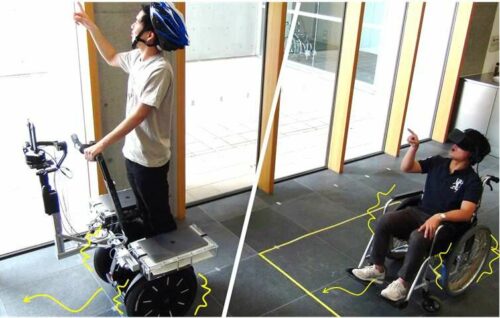Researchers have developed a virtual reality (VR) remote collaboration system which lets users on Segways share not only what they see but also the feeling of acceleration as they move

Virtual reality enables users to look around and immerse themselves in a virtual world. The most noticeable downside of using VR is, it causes motion sickness to the users, as the eyes tell the brain that the user is moving around in the virtual world but the body feels like sitting on a chair. Hence, users experience nauseous even after a short session. To avoid this, researchers from Tokyo Metropolitan University led by Assistant Professor Vibol Yem have created a system that lets users share what they see and the sensation of movement.
The remote collaboration system is integrated with cameras and accelerometers that can feedback on their sensations to a remote user in a modified wheelchair wearing a VR headset. They focused on Segways as a common, widely available personal mobility vehicle, mounting two 3D cameras and a set of accelerometers to measure visual cues and detailed information on the vehicle’s acceleration. This was fed back via the internet to a remote user wearing a VR headset on a modified wheelchair, with separate motors attached to the wheels.
The system makes the wheelchair move, allowing remote users not only to see the same scenery but feel the same acceleration as the user on the Segway accelerated. While the wheelchair wasn’t allowed to move the same distances as the Segway; it was gently returned to its original position when the Segway was not accelerating. The team experimented with their device by asking volunteers to become remote users and rate their experience. There was a reduction in VR sickness of 54% when the sensations of the movement were added, with excellent ratings for the user experience. They also noticed subtleties in how the information should be fed back. For example, users found it best when around 60% of the acceleration suggested by the visual cues was fed back to the wheels, largely due to the sensitivity of the vestibular system (how we sense balance, orientation, and motion) compared to our vision.
The team’s system shows exciting new possibilities for remote collaboration, freeing remote users from a major drawback of VR technology.
Click for the Published Research Paper and Demo Video





